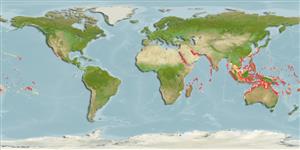>
Eupercaria/misc (Various families in series Eupercaria) >
Scaridae (Parrotfishes) > Scarinae
Etymology: Chlorurus: Greek, chloros = green + Greek oura = tail (Ref. 45335).
More on author: Rüppell.
Environment: milieu / climate zone / Tiefenbereich / distribution range
Ökologie
seewasser riff-verbunden. Tropical
Western Indian Ocean: Red Sea. The species complex comprise of Chlorurus gibbus in the Red Sea, Chlorurus strongylocephalus in the Indian Ocean and Chlorurus microrhinos in the West Central Pacific.
Size / Gewicht / Alter
Geschlechtsreife: Lm ? range ? - ? cm
Max length : 70.0 cm TL Männchen/unbestimmt; (Ref. 30573); max. veröff. Gewicht: 4.0 kg (Ref. 3488); max. veröff. Alter: 14 Jahre (Ref. 13619)
Usually in groups on the outer reef (Ref. 30573). Caught with nets, and other types of artisanal gears.
Life cycle and mating behavior
Geschlechtsreife | Fortpflanzung | Ablaichen | Eier | Fecundity | Larven
Oviparous, distinct pairing during breeding (Ref. 205).
Parenti, P. and J.E. Randall, 2000. An annotated checklist of the species of the labroid fish families Labridae and Scaridae. Ichthyol. Bull. J.L.B. Smith Inst. Ichthyol. (68):1-97. (Ref. 35918)
IUCN Rote Liste Status (Ref. 130435: Version 2025-1)
Bedrohung für Menschen
Reports of ciguatera poisoning (Ref. 30907)
Nutzung durch Menschen
Fischereien: kommerziell; Aquarium: Kommerziell
Tools
Zusatzinformationen
Download XML
Internet Quellen
Estimates based on models
Preferred temperature (Ref.
123201): 24.6 - 29, mean 28 °C (based on 938 cells).
Phylogenetic diversity index (Ref.
82804): PD
50 = 0.5000 [Uniqueness, from 0.5 = low to 2.0 = high].
Bayesian length-weight: a=0.01380 (0.00650 - 0.02933), b=3.03 (2.85 - 3.21), in cm total length, based on LWR estimates for this (Sub)family-body shape (Ref.
93245).
Trophic level (Ref.
69278): 2.0 ±0.00 se; based on food items.
Widerstandsfähigkeit (Ref.
120179): niedrig, Verdopplung der Population dauert 4,5 - 14 Jahre. (K=0.22; tmax=14).
Fishing Vulnerability (Ref.
59153): Moderate to high vulnerability (48 of 100).
🛈
Nutrients (Ref.
124155): Calcium = 23 [9, 75] mg/100g; Iron = 0.518 [0.202, 1.302] mg/100g; Protein = 18.7 [16.6, 20.5] %; Omega3 = 0.084 [0.038, 0.174] g/100g; Selenium = 40.4 [13.3, 119.1] μg/100g; VitaminA = 39.4 [11.8, 126.5] μg/100g; Zinc = 1.86 [0.84, 3.33] mg/100g (wet weight);
